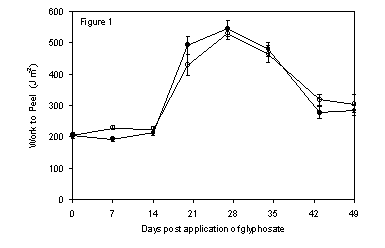
Flax (Linum usitatissimum L.) is an industrial crop which is grown for its fibre. In 1999 an area of approximately 15,000 hectares were grown in the United Kingdom. In order to remove the fibre from the stem it is left to decompose by the action of fungi and bacteria, this process is called retting. To determine when the crop is ready to harvest a subjective retting test is usually carried out by the farmer or an agronomist. Current research aims to try and quantify the degree of retting using different types of mechanical tests (Goodman et al., 2000; Goodman et al., 2002).
Introduction

The process of retting (the dissociation of the fibre bundles from the central stele by the action of microbes) in two varieties of flax (Laura and Escalina) was investigated by studying the morphology and mechanics of plants after treatment with a translocated herbicide glyphosate. The mechanical changes in the stems were measured on a weekly basis by carrying out a series of mechanical peel (see photo) and tear tests on the stem tissue of mature plants.
Results

There was a pronounced drop in the moisture content of the stem 14 days after application of the herbicide from a moisture content of about 60% to 10%. This was consistent with the onset of senescence and subsequent dehydration of the plant tissues. The dehydration of the stem tissues corresponded with an increase in the work required to peel the fibre bundles from the secondary phloem from 212±7.9 Jm-2 to 539±22 Jm-2 (P<0.001) (Fig. 1). However 27 days after application of the herbicide there was a more gradual, but significant drop in the work required to peel the stem by about 45% to a mean work to peel of 297±19.8 Jm-2 (Fig. 1). This is thought to be a result of colonisation of the stem by microbes.
Conclusion
- This study indicates that peel tests can be used to measure mechanical changes in the interface between the fibre bundles and the secondary phloem tissue.
- It enables the progression of retting to be monitored and allows comparisons to be made to determine the optimum harvest time for flax (Goodman et al., 2002).
